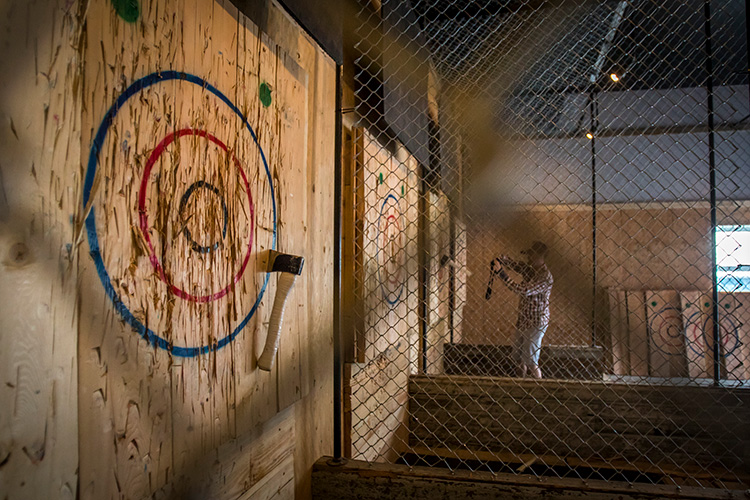Axe Throwing Denver CO: Fun for Everyone, from Pals to Households
Axe Throwing Denver CO: Fun for Everyone, from Pals to Households
Blog Article
The Fun of Axe Throwing: Exactly How This Sport Incorporates Ability and Adrenaline for a Blast
Axe throwing has become an astounding sport that masterfully links the need for precise ability with the rush of adrenaline, offering participants a appealing and unique experience. The act of tossing an axe towards a target demands concentration and technique, concurrently promoting an atmosphere of camaraderie and pleasant competition. This appealing mix of mental focus and physical effort has made axe throwing a prominent choice for those seeking both leisure and a feeling of achievement. To really appreciate the deepness and charm of this task, one must consider its beginnings, the essential tools, and the fundamental methods that ensure both safety and enjoyment.
The Beginnings of Axe Throwing
Axe throwing, a leisure activity that has gotten substantial appeal in recent years, traces its origins back to ancient times. The earliest documents of axe usage in competitive contexts are located among the Celts and Vikings, that tossed axes for sporting activity as well as in battle training.
Medieval European warriors, specifically throughout the Center Ages, exercised axe throwing as component of their martial training. The Francisca, a kind of tossing axe made use of by the Franks, became renowned for its dangerous accuracy. This typical weapon was designed to be thrown at adversary shields and shield, showcasing its double utility in both sport and fight.
In more recent background, axe throwing saw a resurgence in the logging camps of North America in the 19th and 20th centuries. Lumberjacks would engage in pleasant competitors, checking their accuracy and strength by aiming at wood targets. This evolution from a survival ability to a recreational activity has led the way for its modern-day renewal, with committed locations and leagues currently commemorating the sporting activity globally.
Tools You Required
Understanding the abundant background of axe tossing boosts the admiration of the sporting activity's contemporary model. Central to this thrilling activity is the devices, which is essential for both security and efficiency. The main tool is, naturally, the axe. For competitive and recreational axe tossing, the most generally made use of type is the hatchet, commonly considering between 1.25 to 2 pounds with a manage size of around 16 inches. The axe must have a sharp, properly maintained blade and a handle made from sturdy wood or composite product, making sure an excellent grip and balance.
Equally essential is the target. Law targets are created from timber, with softwood ranges like yearn or cottonwood being chosen for their capacity to soak up and hold the axe. The target is normally divided right into 5 concentric circles, each with a details factor worth, to help with scoring.
Safety and security gear, though often overlooked, is essential. Protective gloves can boost grasp and stop blisters, while closed-toed footwear are a must to protect feet from dropped axes (denver axe throwing). A well-lit, sizable tossing area, complete with safety and security barriers, makes certain a regulated atmosphere where participants can focus on developing their abilities.
Fundamental Techniques Discussed
Understanding the essential strategies of axe throwing is vital for both safety and effectiveness. The leading hand find needs to be placed directly listed below the axe head, while the non-dominant hand sustains the end of the deal with.
Next, concentrate on the position. Stand with your feet shoulder-width apart, guaranteeing your body is stabilized. Your leading foot should be slightly onward, straightening with your target. This positioning aids in maintaining security and guiding power precisely towards the target.

Security First
Guaranteeing safety in axe throwing is critical to developing a satisfying and injury-free experience. A properly designed axe tossing center attributes clear demarcations between tossing lanes, strong backdrops to capture roaming axes, and non-slip floor covering to protect against accidents.
Benefits of Axe Throwing
Axe tossing offers a myriad of advantages that extend beyond straightforward leisure. Literally, it supplies a full-body exercise, engaging muscular tissues in the arms, shoulders, back, and core. The recurring movement of throwing the axe additionally enhances hand-eye control and great motor abilities. For those wanting to improve their general fitness, axe throwing can work as a vibrant and engaging kind of exercise.
Psychologically, axe tossing needs focus, accuracy, and technique, making it a superb way to develop cognitive abilities. The focus required to strike the target can function as a form of mindfulness, allowing participants to remove their minds and lower tension. This psychological involvement can be especially beneficial in helping people create better problem-solving abilities and psychological strength.
Socially, axe throwing is frequently appreciated in group setups, cultivating team-building and camaraderie. Whether as part of a corporate event or an informal outing with good friends, the sporting activity motivates interaction and partnership. Furthermore, the communal experience of learning and boosting together can reinforce relationships and produce lasting memories.
Conclusion

The earliest documents of axe usage in competitive contexts are located among the Celts and Vikings, that tossed axes for sport as well as in battle training. Release the axe when your hands are around at eye level, permitting the axe's all-natural turning to assist it in the direction of the target.
A properly designed axe tossing facility attributes clear separations between throwing lanes, strong backgrounds to capture stray axes, and non-slip flooring to protect against mishaps. Individuals should be advised on the correct method to handle and toss the axe, stressing managed, intentional activities over forceful tosses.
In summary, axe tossing stands out as a sporting activity that masterfully integrates adrenaline, ability, and precision.
Report this page